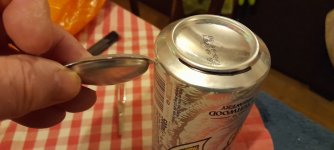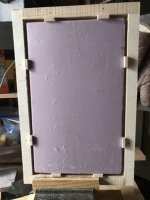Steve, So it looks like you are only using the foot of the can. I hadn't even thought of just that as being the whizzer. Thanks for the great picture, and for your kind help. So the inside of the can foot is glued to the canvas, correct? I don't drink soda, and I haven't had a beer in a long time.
Let's see if the dome will bring the levels more into lineIt's nice to have the brightness without the pain 😁
The trouble with whizzer cones is trying to match the efficiency of the whizzer to the panel for a flat frequency response for general use,( no volume control ).
Steve.
jaxboy.
just for you ,this is a recording of two art panels one with the whizzers and one without.
i would recommend listening to the recording without first as this recording will sound rather dull after listening to the one with the whizzer.
making the whizzer smaller might lower the output or not mounting the whizzer in the central area of the dome might help damp it a little ?
have a listen and tell me how it sounds to you.
steve.
just for you ,this is a recording of two art panels one with the whizzers and one without.
i would recommend listening to the recording without first as this recording will sound rather dull after listening to the one with the whizzer.
making the whizzer smaller might lower the output or not mounting the whizzer in the central area of the dome might help damp it a little ?
have a listen and tell me how it sounds to you.
steve.
Attachments
Steve,
Is that with the can whizzer? I do like it better with the whizzer. Not in-your-face livelier, but just brighter, more "there". Definitely worth the effort. Thanks.
Is that with the can whizzer? I do like it better with the whizzer. Not in-your-face livelier, but just brighter, more "there". Definitely worth the effort. Thanks.
Jaxboy.
Just compared the can whizzer with the coffee whizzer.
The coffee whizzer has a broader frequency response and is only a few dB louder than the art panel , which would be a better match for that panel, for normal use that is.
Matching a whizzer to a panel is a bit hit and miss.
Mounting the whizzer by one small point on its base makes it very efficient.
I was wondering if extending the coil former on the whizzer side might damp it down a little bit more, or maybe cause more problems?
But this method is definitely viable, I think, to be able to blend in the sort of sound you want without using EQ.
If you have the patience and knowhow.
When you get things sorted out and you are recovered, you might want to try this especially as it is easy and free , although you might have to buy a can of beer 🍺 😉
Steve.
Just compared the can whizzer with the coffee whizzer.
The coffee whizzer has a broader frequency response and is only a few dB louder than the art panel , which would be a better match for that panel, for normal use that is.
Matching a whizzer to a panel is a bit hit and miss.
Mounting the whizzer by one small point on its base makes it very efficient.
I was wondering if extending the coil former on the whizzer side might damp it down a little bit more, or maybe cause more problems?
But this method is definitely viable, I think, to be able to blend in the sort of sound you want without using EQ.
If you have the patience and knowhow.
When you get things sorted out and you are recovered, you might want to try this especially as it is easy and free , although you might have to buy a can of beer 🍺 😉
Steve.
Steve,
Oh, no! Oh, well, I guess I'll have to suffer and drink a beer. Take one for the team and all that. lol Thanks, Steve.
Oh, no! Oh, well, I guess I'll have to suffer and drink a beer. Take one for the team and all that. lol Thanks, Steve.
Jaxboy.
If it makes you feel any better, it's Friday night and I am going to have to force a couple of beers down me, as my wife will insist I join her 🤪
I glued the other 5inch matchstick panel together again, so that I could hear them together.
This is also a viable option as long as you do not want to go down below 400hz.
I did not bother recording them as they sound pretty much the same as without the matches.
Not that you would notice on a recording.
Thought I would just mention it, in case anyone was interested.
Just to mention that it works, but for what use I do not know?
Steve.
If it makes you feel any better, it's Friday night and I am going to have to force a couple of beers down me, as my wife will insist I join her 🤪
I glued the other 5inch matchstick panel together again, so that I could hear them together.
This is also a viable option as long as you do not want to go down below 400hz.
I did not bother recording them as they sound pretty much the same as without the matches.
Not that you would notice on a recording.
Thought I would just mention it, in case anyone was interested.
Just to mention that it works, but for what use I do not know?
Steve.
Steve,
Taking one for the team! That's the spirit! I hope wifey understands the sacrifices you make for her.
Taking one for the team! That's the spirit! I hope wifey understands the sacrifices you make for her.
What microphone>USB convertors are y'awl using or what convertors would you recommend for your measurements?
My old UCA222 needs to be replaced.
I especially want to know if any of the USB interfaces will convert DC input voltages as well.
My old UCA222 needs to be replaced.
I especially want to know if any of the USB interfaces will convert DC input voltages as well.
Hello André,What microphone>USB convertors are y'awl
Mainly an umik1 which is directly USB. You can have a look in posts from #6361.Or #4906 for an alternative to umik1 but I don't remember many posts about USB sound cards.
Christian
If you guys don't use USB convertors, then how do you get your timing references sorted out? Do you loop back via the computer sound card (mini-jack) inputs/outputs?
How do you do impedance measurements, also via mini-jack ins & outs?
How do you do impedance measurements, also via mini-jack ins & outs?
Good question André,If you guys don't use USB convertors, then how do you get your timing references sorted out? Do you loop back via the computer sound card (mini-jack) inputs/outputs?
How do you do impedance measurements, also via mini-jack ins & outs?
I made few tests with loop back on a second channel. For that I used a Hn1 Zoom hand recorder. It has the possibility of an external input so you can plug on it an external mic. The Hn1 is a not too bad USB converter... connected to the computer some noise appears.
For now I don't have an impedance measurement set up. Missing in my tool box!.
good morning to all of you
a question according to you from your own experience
how much does the thickness of the frame affect the sound,
given that at the moment it is all in wood and to make no mistake I used a very dense and very hard high quality wood to avoid vibrations of any kind, what I would like to know if it were much thinner or even made of plastic material, remaining zero spurious vibrations Do you think the timbre would change?
a question according to you from your own experience
how much does the thickness of the frame affect the sound,
given that at the moment it is all in wood and to make no mistake I used a very dense and very hard high quality wood to avoid vibrations of any kind, what I would like to know if it were much thinner or even made of plastic material, remaining zero spurious vibrations Do you think the timbre would change?
I don't think it's the thickness, per se, that's important, but rather the stiffness of the frame. .how much does the thickness of the frame affect the sound,
Depending how you have damped the edges of the panel, the frame might make a greater or lesser difference. There are many variables.
I agree with Andre. There are too many variable for a definitive answer. I know that for my current favorite design (a panel with an aspect ratio approaching 4:1, and with the plate attached to the frame around nearly the entire perimeter) it's critical to have a very stiff frame. In fact, I have found some bracing to be needed. But that may not be true of every design.There are many variables.
Eric
Audiofrenzy said:Most full range cone drivers are usually 4 inches when you look at famous brands like Fostex and Mark Audio. So IMO the standard width for DML's should be around 7or 8inches give or take a couple inches. The height can be equal to the width or at maximum double the width. I prefer 4-6inches more then the width.
So around 7-8inches for the width and 11-14inches for the height.
Okay, I built a 7 x 11ish in a frame. right now, the foam is tight. Does it need to just barely touch? or how much friction? I have enough 60 grit sandpaper to dial it in.
The next question is, what Dayton (or other) exciter do you recommend for this? I have 6 watters now, more 40 watters are on the way. The 40s just seem awfully big for this small piece of foam but I'll go with it if that's what you tell me.
And then, does it go dead center, not 2/5s? (I assume it needs to be center for this application, just making sure)
Next, is it best to stick the exciter directly to the pad, or do I need to stick it to a thin piece of wood, and the wood to the foam? I can resaw a wood plate to whatever dimension you say it needs to be.
from there i'll try to find a non-destructive way to connect to the spine but glue if I have to.
Attachments
It should be tight as possible.
6watts is good for this small panel size.
Either dead center or 1/2inch off dead center.
The magnet of the exciter is glued on directly to the spine while the voice coil of the exciter is glued (2 part epoxy adhesive) directly to the foam.

6watts is good for this small panel size.
Either dead center or 1/2inch off dead center.
The magnet of the exciter is glued on directly to the spine while the voice coil of the exciter is glued (2 part epoxy adhesive) directly to the foam.
Also if you decide to place the exciter 1/2inch off center the left and right panels have to be opposite exciter placements.
Dead center will provide more prominent midrange in vocals, while 1/2inch off dead center will have less prominent midrange vocals.
Dead center will provide more prominent midrange in vocals, while 1/2inch off dead center will have less prominent midrange vocals.
- Home
- Loudspeakers
- Full Range
- A Study of DMLs as a Full Range Speaker

